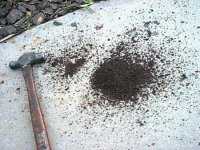jamyers":k7nuondt said:
Hmmm...
I'd recommend spending the $50 and getting a GOOD temp gauge that'll give you accurate, measured readings...Once you know that, then it looks like the only thing left to do is replace the radiator - which is what I'll bet it's needing.
+1 That would be the way I'm leaning based upon what you've already done. What's surprising (as I experienced the same thing when I changed to a new aluminum radiator...fleabay as well) is the improvement in cooling some seem to be experiencing going from copper to aluminum (I had similar results)...when copper is by far a better thermal conductor than aluminum (transfers heat better).
http://en.wikipedia.org/wiki/Thermal_conductivity
Lead 35.3
Aluminium 237 (pure)
120—180 (alloys)
Gold 318
Copper 401
Silver 429
Diamond 900 - 2320
Almost 2 to 1...although not quite as good as the stuff you can't afford to build a radiator out of

This leads me to believe that the new aluminum radiators probably have 1) some improvement in design (larger rows or some such) and 2) that the old copper ones being replaced are really on their last legs (as mine was) in order to see such a drastic improvement over copper which is better as disapating heat. I'd probably think it's more the latter with regard to the age of most of these old rads. Makes you wonder what a brand new copper would do

Of course aluminum also has the additional benefit of being cheaper (it's in all new car rads...that and plastic), also lighter, and lastly but not any less important IMHO is they don't corrode/oxidize in the same way over time. A closed system that's kept regularly treated with rust inhibitor aka coolant (the other purpose of anti-freeze) should not corrode excessivley fast but in similar conditions it's my understanding that copper will corrode faster or otherwise stated is going to have more waste product/corrosion material to potentially clog the system over the years especially with the help of the iron oxide being manufactured in the hollows of the head/block.
EDIT: basically what Jack was saying...overload of crud, crud, crud
The other thing I'd like to weigh in on...count me in the camp that does not believe changing thermostats is going to affect your engines running temp significantly.
The engine running temp is what the engine running temp is. You can temporarily impact it by changing thermostats, but its only temporary. Say the engine is running/peaks at 210 on a hot day...when cooler water from the radiator is allowed to enter the engine or conversely warmer water from the engine is allowed to enter the radiator...the temp may fall...but only temporarily...then the engine is immediately trying to get back to the 210 it was running at (given ambient temperature stays the same). If it's a cooler day and the engine tops the temps at 200...then same thing...at whatever point the water enters the engine from rad or leaves the engine to go to the rad (ie fully circulates) the running temp is only impacted temporarily then the engine again wants to seek out its normal running temp (given capacity and efficiency of the cooling system combined with ambient temperature effects).
Seems there's a few good threads going today on overheating so thought I'd throw my $.02 in here...gotta like the theory talk

...but don't intend to trivialize your current concern mustangsilly...good luck with the new rad


